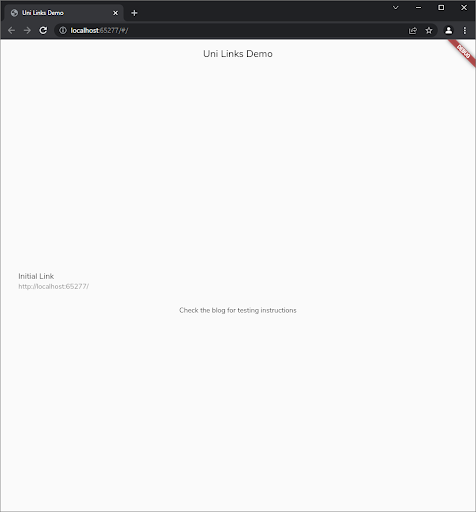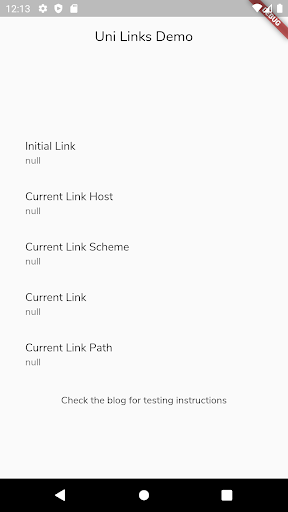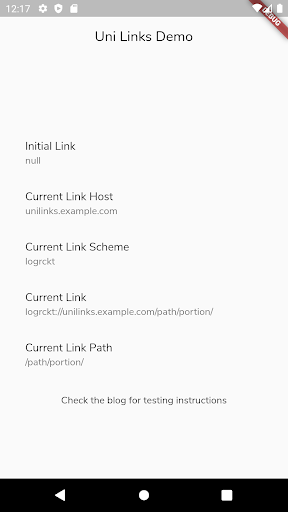Deep linking provides you with a web browser link that points to a specific part of an app that is already installed. These links can also be set to navigate users to specific content pages (like events, news updates, and more) and pass through custom data (like promo codes).
For example, if you want to share this article with a friend, then you would send a URL pointing to this article, not the blog.logrocket.com website to navigate through and look for the article themselves. This means you need to handle the way your application is triggered manually or using a deep link.
Additionally, your app might already be running when the deep link is triggered, so you need to handle deep link clicks in your background running app as well.
In this tutorial, you’ll learn how to use uni_links to help you with this.
N.B., if you are new to Flutter, please go through the official documentation to learn about it.
What are Uni Links?
Uni Links (uni_links) is a Flutter plugin used for receiving incoming App/Deep Links (for Android) and universal links and custom URL schemes (for iOS).
It currently supports Android, iOS, and web platforms.
Setting up Uni Links
Add uni_links in the pubspec dependencies:
uni_links: ^0.5.1
Next, you need to declare the link’s schema in the Android or iOS configuration file.
Android config
In Android, there are two types of Uni Links:
- App Links: This link requires a specified host, a hosted file (
assetlinks.json), and it only works with thehttpsscheme (https://your_host). Here’s the App Link intent filter that you need to add to your configuration file. You can change the host to your liking:<!-- App Links --> <intent-filter android:autoVerify="true"> <action android:name="android.intent.action.VIEW" /> <category android:name="android.intent.category.DEFAULT" /> <category android:name="android.intent.category.BROWSABLE" /> <!-- Accepts URIs that begin with https://YOUR_HOST --> <data android:scheme="https" android:host="unilinks.example.com" /> </intent-filter> - Deep Links: This link doesn’t require a host, a hoster file, or any custom scheme. It provides a way to utilize your app using URL: your_scheme://any_host. Here’s the Deep Link intent filter that you need to add to your configuration. You can also change the scheme and host:
<!-- Deep Links --> <intent-filter> <action android:name="android.intent.action.VIEW" /> <category android:name="android.intent.category.DEFAULT" /> <category android:name="android.intent.category.BROWSABLE" /> <!-- Accepts URIs that begin with YOUR_SCHEME://YOUR_HOST --> <data android:scheme="logrckt" android:host="unilinks.example.com" /> </intent-filter>
You need to declare either of these intent filters in your main AndroidManifest.xml file (android/app/src/main/AndroidManifest.xml).
iOS config
In iOS, there are also two types of uni links:
- Universal Links: These only work with the
httpsscheme and require a specified host, entitlements, and a hosted file. Similar to App Links in Android. You need to add or create acom.apple.developer.associated-domainsentitlement, either through Xcode or by editing theios/Runner/Runner.entitlementsfile:<?xml version="1.0" encoding="UTF-8"?> <!DOCTYPE plist PUBLIC "-//Apple//DTD PLIST 1.0//EN" "http://www.apple.com/DTDs/PropertyList-1.0.dtd"> <plist version="1.0"> <dict> <!-- ... other keys --> <key>com.apple.developer.associated-domains</key> <array> <string>applinks:[YOUR_HOST]</string> </array> <!-- ... other keys --> </dict> </plist> - Custom URL: This URL doesn’t require a host, entitlements, a hosted file, or any custom scheme. Similar to a Deep Link in Android, you need to add the host and scheme in the
ios/Runner/Info.plistfile as below:<key>CFBundleURLTypes</key> <array> <dict> <key>CFBundleTypeRole</key> <string>Editor</string> <key>CFBundleURLName</key> <string>unilinks.example.com</string> <key>CFBundleURLSchemes</key> <array> <string>logrckt</string> </array> </dict> </array>
N.B, any app can claim your scheme and host combination in the case of Deep Links in Android and Custom URLs in iOS, so ensure that your host and scheme are as unique as possible.
Usage
As mentioned earlier, there are two ways that your app will handle a deep link:
- Cold start: A cold start is starting the app anew if the app was terminated (not running in the background). In this case,
_initURIHandlerwill be invoked and have the initial link - Coming back to the foreground: If the app is running in the background and you need to bring it back to the foreground, the Stream will produce the link. The initial link can either be null or be the link with which the app started
The _initURIHandler should be handled only once in your app’s lifecycle, as it is used to start the app and not to change throughout the app journey. So, create a global variable _initialURILinkHandled as false anywhere in your main.dart:
bool _initialURILinkHandled = false;
In your main.dart file, clean your MyHomePage widget by removing the existing code and creating new variables as below:
Uri? _initialURI; Uri? _currentURI; Object? _err; StreamSubscription? _streamSubscription;
Here you are declaring:
- Two
Urivariables to identify the initial and active/current URI, - An
Objectto store the error in case of link parsing malfunctions - A
StreamSubscriptionobject to listen to incoming links when the app is in the foreground
Next, create the _initURIHandler method as below:
Future<void> _initURIHandler() async {
// 1
if (!_initialURILinkHandled) {
_initialURILinkHandled = true;
// 2
Fluttertoast.showToast(
msg: "Invoked _initURIHandler",
toastLength: Toast.LENGTH_SHORT,
gravity: ToastGravity.BOTTOM,
timeInSecForIosWeb: 1,
backgroundColor: Colors.green,
textColor: Colors.white
);
try {
// 3
final initialURI = await getInitialUri();
// 4
if (initialURI != null) {
debugPrint("Initial URI received $initialURI");
if (!mounted) {
return;
}
setState(() {
_initialURI = initialURI;
});
} else {
debugPrint("Null Initial URI received");
}
} on PlatformException { // 5
debugPrint("Failed to receive initial uri");
} on FormatException catch (err) { // 6
if (!mounted) {
return;
}
debugPrint('Malformed Initial URI received');
setState(() => _err = err);
}
}
}
In the above code, you have done the following:
- Used a check here so that the
_initURIHandlerwill only be called once even in case of a widget being disposed of - Displayed a toast using the
fluttertoastpackage when this method was invoked - Used the
getInitialUrimethod to parse and return the link as a new URI ininitialURIvariable - Checked whether the
initialURIis null or not. If not null, set up the_initialURIvalue w.r.tinitialURI - Handled the platform messages fail using
PlatformException - Handled the
FormatExceptionif the link is not valid as a URI
Next, create the _incomingLinkHandler method used to receive links while the app is already started:
void _incomingLinkHandler() {
// 1
if (!kIsWeb) {
// 2
_streamSubscription = uriLinkStream.listen((Uri? uri) {
if (!mounted) {
return;
}
debugPrint('Received URI: $uri');
setState(() {
_currentURI = uri;
_err = null;
});
// 3
}, onError: (Object err) {
if (!mounted) {
return;
}
debugPrint('Error occurred: $err');
setState(() {
_currentURI = null;
if (err is FormatException) {
_err = err;
} else {
_err = null;
}
});
});
}
}
This code did the following:
- Added a condition to check the platform, as the web platform will handle the link as an initial link only
- Listen to the stream of incoming links and update the
_currentURIand_errvariables - Handled errors using the
onErrorevent and updated the_currentURIand_errvariables
After creating these methods to listen to the incoming links, you need to call them before the Widget tree is rendered. Call these methods in the initState of the MyHomePage widget:
@override
void initState() {
super.initState();
_initURIHandler();
_incomingLinkHandler();
}
Similarly, to let go of the resources when the app is terminated, close the StreamSubscription object in the dispose method:
@override
void dispose() {
_streamSubscription?.cancel();
super.dispose();
}
Next, update the build method:
@override
Widget build(BuildContext context) {
return Scaffold(
appBar: AppBar(
title: Text(widget.title),
),
body: Center(
child: Padding(
padding: const EdgeInsets.symmetric(horizontal: 20),
child: Column(
mainAxisAlignment: MainAxisAlignment.center,
children: <Widget>[
// 1
ListTile(
title: const Text("Initial Link"),
subtitle: Text(_initialURI.toString()),
),
// 2
if (!kIsWeb) ...[
// 3
ListTile(
title: const Text("Current Link Host"),
subtitle: Text('${_currentURI?.host}'),
),
// 4
ListTile(
title: const Text("Current Link Scheme"),
subtitle: Text('${_currentURI?.scheme}'),
),
// 5
ListTile(
title: const Text("Current Link"),
subtitle: Text(_currentURI.toString()),
),
// 6
ListTile(
title: const Text("Current Link Path"),
subtitle: Text('${_currentURI?.path}'),
)
],
// 7
if (_err != null)
ListTile(
title:
const Text('Error', style: TextStyle(color: Colors.red)),
subtitle: Text(_err.toString()),
),
const SizedBox(height: 20,),
const Text("Check the blog for testing instructions")
],
),
)));
}
Here, you have done the following:
- Displayed the Initial Link if received using the
_initialURIvariable - Added a check to display the incoming links only on mobile platforms
- Displayed the host of the incoming link. We have already defined the host earlier
- Similar to host, displayed the scheme of the incoming link configured earlier
- Displayed the current or active incoming link using the
_currentURIvariable - Displayed the path coming along with the host and scheme
- Displayed the error if it is not null
Build and restart your application; it’ll look like this:


All of the subtitles of the ListTile will be null for mobile because the app restarted manually. In the next step, you’ll test your changes.
Testing your deep links
You can test your changes by using CLI tools for invoking the links with your registered scheme.
Android
If Android Studio (with the SDK platform-tools) is already installed, you could do the following:
adb shell 'am start -W -a android.intent.action.VIEW -c android.intent.category.BROWSABLE -d "logrckt://host/path/subpath"' adb shell 'am start -W -a android.intent.action.VIEW -c android.intent.category.BROWSABLE -d "logrckt://unilinks.example.com/path/portion/?uid=123&token=abc"' adb shell 'am start -W -a android.intent.action.VIEW -c android.intent.category.BROWSABLE -d "logrckt://unilinks.example.com/?arr%5b%5d=123&arr%5b%5d=abc&addr=1%20Nowhere%20Rd&addr=Rand%20City%F0%9F%98%82"' adb shell 'am start -W -a android.intent.action.VIEW -c android.intent.category.BROWSABLE -d "logrckt://unilinks.@@malformed.invalid.url/path?"'
This will send calls according to your scheme and host to your app and your app will come to the foreground.
If you don’t have ADB in your path, but have the $ANDROID_HOME env variable, then use "$ANDROID_HOME"/platform-tools/… and the above commands.
Alternatively, you could simply run the command in an ADB shell.
iOS
If Xcode is already installed, you could do the following:
/usr/bin/xcrun simctl openurl booted "logrckt://host/path/subpath" /usr/bin/xcrun simctl openurl booted "logrckt://unilinks.example.com/path/portion/?uid=123&token=abc" /usr/bin/xcrun simctl openurl booted "logrckt://unilinks.example.com/?arr%5b%5d=123&arr%5b%5d=abc&addr=1%20Nowhere%20Rd&addr=Rand%20City%F0%9F%98%82" /usr/bin/xcrun simctl openurl booted "logrckt://unilinks.@@malformed.invalid.url/path?"
If you have xcrun (or simctl) in your path, you could invoke it directly. The flag booted assumes an open simulator with a booted device.
N.B, for App Links or Universal Links, you can try the above example with the https scheme for logrckt.

Conclusion
You can find the final project here.
In this tutorial, you learned about deep linking and how can you use it in your Flutter app. For the next step, you can try deep linking using Firebase Dynamic Links because they work even if the app is not installed by the user by redirecting them to the Play/App Store for installation.
The post Understanding deep linking in Flutter with Uni Links appeared first on LogRocket Blog.
from LogRocket Blog https://ift.tt/wq2jl0n
via Read more



